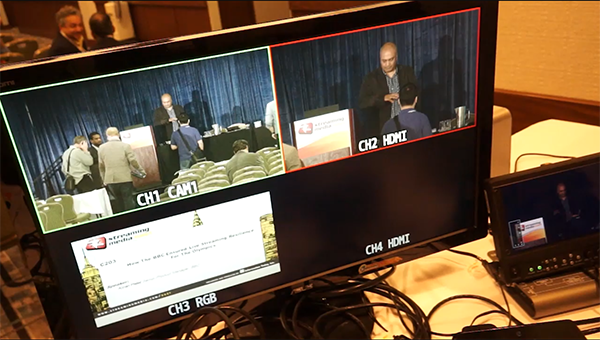Behind the Scenes: How to Produce a Live-Switched Webcast
Go behind the scenes at Streaming Media East 2013's 4-track, 3-day, live-switched conference and 1-day webcast with producer and crew chief Shawn Lam and see the process and the gear and how it all fits together in live-switched webcast production.
At Streaming Media East 2013 in New York last week, I assembled a crew to shoot and switch and record all four conference tracks, plus the 2-track Content Delivery Summit that took place the day before the Streaming Media East program began. On Tuesday, the first day of the show, we also live-switched and live-streamed the keynotes and the entire day’s sessions from the keynote room. Figure 1 (below) shows me working here behind the video production table in the keynote room, one of the four that we're taking care of.

Figure 1. Shawn Lam switching and producing video at Streaming Media East 2013.
HD Video Switcher: The Roland V40 HD
At the center of our production workflow was the new Roland V40 HD video switcher (Figure 2, below). It's an entry-level professional video switcher that has HDMI inputs. We used it with two video cameras that are connected via HDMI. We also connecting a VGA input, coming from the presenter's laptop.

Figure 2. The Roland V40 HD switcher.
One of the nice features of this video switcher is the fact you can mix both high-definition HDMI video as well as analog VGA. A lot of video switchers lack that capability, and unfortunately, much of the AV presentation world is still stuck on the VGA standard, so having the ability to put VGA inputs on an HDMI video switcher is excellent. It also has built-in video scalers on each input, which is advantageous because the VGA signal often isn't the same size, so I do have the ability in the menu to scale the signal up to fill the frame if it's a bit undersized as well.
Figure 3 (below) shows the multiview monitor. It's coming straight out of the V40 HD video switcher, and it's an HDMI output. It allows me to see the live feed--the program feed--as well as the preview and any additional inputs that are available to me. I can change the live camera by pressing the A-bus program line, and I can change the B-bus, which is the next video feed on deck. And, then using the T-bar, I can also cut between them.

Figure 3. The V40 HD Multiview Monitor.
The signal from the V40 HD feeds out into a variety of different things, but the most important for the live webcast is the Teradek Cube (Figure 4, below), which takes HD-SDI input. In our setup at Streaming Media East we had an Ethernet Internet input coming in, and we live-streamed it to Ustream.

Figure 4. The Teradek Cube
Related Articles
In this ongoing Streaming Media Producer series on webcast video production, Shawn Lam covers the video format converters he uses in his own HD webcast workflows, and one new converter that just might be the video converter, scaler, and distribution amplifier to rule them all.
New camera-mounted Atomos recorder/monitor adds essential set up tools with full waveform monitor functions, including vectorscope, RGB and LUMA parades with transparent overlay and bottom right, lower 3rd or full screen positioning, making it an extremely flexible too